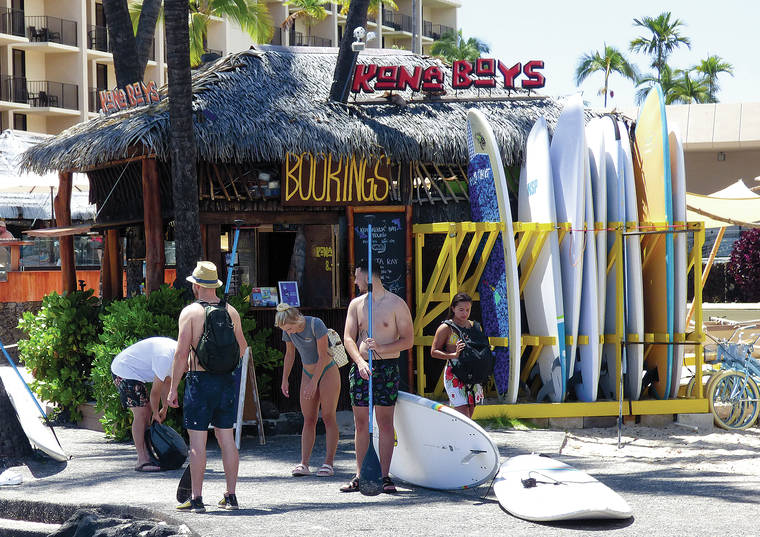Too many tourists? Inaba wants to cut tourism promotion

Visitors launch a rental kayak into Kailua Bay Friday afternoon. North Kona Councilman Holeka Inaba, concerned that other areas of the budget, including council contingency funds, were being neglected, on Thursday proposed taking $359,000 from the Department of Research and Development’s $459,000 line item for tourism promotion contract services to put it where he thought it was needed more. (Chelsea Jensen/West Hawaii Today)

Visitors prepare to head out onto the water after renting standup paddleboards at Kona Boys Beach Shack at Kamakahonu Beach Friday afternoon. North Kona Councilman Holeka Inaba, concerned that other areas of the budget, including council contingency funds, were being neglected, on Thursday proposed taking $359,000 from the Department of Research and Development’s $459,000 line item for tourism promotion contract services to put it where he thought it was needed more. (Chelsea Jensen/West Hawaii Today)
Should the county continue pumping money into tourism promotion when tourists seem to come here anyway?
Should the county continue pumping money into tourism promotion when tourists seem to come here anyway?
That was a topic the County Council tackled Thursday as it looked for loose change in a tight $609.1 million budget.
North Kona Councilman Holeka Inaba, concerned that other areas of the budget, including council contingency funds, were being neglected, proposed taking $359,000 from the Department of Research and Development’s $459,000 line item for tourism promotion contract services to put it where he thought it was needed more.
“I feel that this money could be better used elsewhere,” Inaba said. “We have goals that state that tourism is compatible with historic and natural resources. That it’s not intrusive on our local communities, that it helps to strengthen private, public and international partnerships and makes us a resilient community. And I don’t believe that to be true, as we’ve seen over the last year. With tourism gone, we were in the hole.”
Puna Councilman Matt Kanealii-Kleinfelder agreed.
“For the most part, what I’ve heard from people is they’d like to see less tourism,” Kanealii-Kleinfelder said, adding “Going to beaches and finding them almost absolutely empty — there’s a beauty in that we will not get if we focus on increasing tourism.”
Inaba’s measure died on a 3-5 vote, with Kanealii-Kleinfelder and Council Chairwoman Maile David, representing South Kona/Ka‘u, also voting yes.
Tourism is indeed coming back, if more slowly than some in the industry might like. Hawaii Island hotels reported a 53.7% occupancy rate in April, compared to 47% on Oahu, 62.1% in Maui County and 36.9% on Kauai, according to data provided by the Hawaii Tourism Authority. The Big Island’s Kohala Coast hotels were 64.4% occupied.
April data for vacation rental occupancy has yet to be released. However, the lodging choice in March outperformed hotels on the Big Island, reporting an occupancy rate of 70.3%, which was up about 4.5 percentage points from the year prior.
Those voting against the measure said the money, which is distributed through competitive grants, has a focus on responsible tourism, something that’s very needed on the island.
“We want our tourists when they come to come and be pono and responsible tourists. And when we take away this money, we are not going to be able to articulate that message,” said Puna Councilwoman Ashley Kierkiewicz, citing recent examples of bad behavior, or cluelessness about dangers, from visitors at Waipio Valley and Four Miles park.
“I think if we take money away from tourism, especially this marketing piece, we’re not going to be able to articulate when you come here you’ve got to be pono,” she said. “You’ve got to be respectful. You’ve got to know before you go.”
Research and Development Director Doug Adams said the grants emphasize implementing the county’s strategic tourism plan, focusing on demonstrating economic and equitable benefits to Hawaii Island residents. That includes responsible tourism, pono-based visitor communications, place-based education and interpretive pilot programs at culturally and historically important sites, he said.
“We’re working precisely on the things Councilman Inaba is concerned about,” Adams said. “(We want) visitors here connected to the identity of the island and not just on top of it. … That’s where we’re moving and removing these funds doesn’t help us get there. It actually makes it more difficult.”
Inaba pointed out there was only $13,128 budgeted for fire station equipment for all the stations on the island, so he wanted to add $50,000 to that. Fire Department funding was so lacking that firefighters had to dig into their own pockets to buy an air conditioner for their windowless station, he said.
He also wanted to put $84,000 into a Parks and Recreation maintenance account for building and construction materials to address some of the deferred maintenance at the facilities. And, he wanted to put $225,000 into contingency accounts, giving each council member $25,000.
Council members get another stab at shifting funds around next month, when the final reading of the budget comes up. County department heads have submitted 135 pages of supplementary budget requests for equipment or staffing that didn’t make it into Mayor Mitch Roth’s budget. Those requests can’t be satisfied without taking money from somewhere else or raising taxes.


